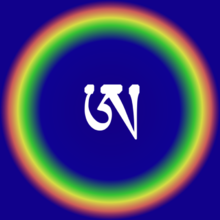| The Instruction Series |
The most influential texts of the "Instruction Series" (mengagde), are the so-called "Seventeen Tantras" (rgyud bcu bdun) and the two "Seminal Heart" collections, namely the Vima Nyingthig (bi ma snying thig, "Seminal Heart of Vimalamitra") and the Khandro Nyingthig (mkha' 'gro snying thig, "Seminal Heart of the Dakini").
The "Seminal Heart of Vimalamitra" is attributed to Vimalamitra, but was largely composed by their discoverers, in the 11th and 12th century, such as Zhangton Tashi Dorje (1097-1127). The "Seminal Heart of the Dakini" was produced by Tsultrim Dorje (1291-1315/17).
These texts present themselves as being taught by Buddhas like Samantabhadra, and discuss numerous topics including: cosmogony, the subtle body, speculation on the gnostic "ground" that underlies the world, buddha-nature, discussions of light-energy, practical techniques for calming the mind and producing visions, ritual empowerments, mandala construction, signs of meditative accomplishment, post-death states, attaining liberation after dying, funerary rituals, relics, prognostications for the time of death, subjugation rituals, as well as strange recipes, and advice for dealing with zombies. There is an emphasis on the importance of "funerary" topics such as death and the intermediate state (bardo), as well as visions of peaceful and fierce deities. The "Secret Instruction" series texts saw themselves as the highest of all Dzogchen teachings, and they eventually overshadowed the other two classes.
The core worldview of the "Seminal Heart" texts as follows:
All of the world’s beings, objects, and appearances are said to rise up from the “ground” (gzhi) of reality, which in its primordial state is a field of pure possibility, beyond differentiation. Awareness serves as the dynamic, knowing dimension of this ground, and acts as a kind of luminous vibrancy that “lights up” (snang) from the “ground”, creating appearances through its “dynamic energy” (rtsal).
In this view, all appearances are simply the “play” (rol pa) or the “radiation” (gdangs) of awareness, with some appearances (such as visionary ones) being awareness appearing in its unclouded intensity, while others (like ordinary objects) are only its dimmed derivations.
In the "Great Perfection", awareness plays a primary role in beings’ enlightenment, as well as their wandering in samsara, the crucial issue separating these two being whether or not awareness is “recognized” (ngoshes pa) for what it is. That is, if beings and their environments are in fact constituted of the same awareness — beings can either recognize that, or they can mistakenly view the world as containing external objects, absolutely separate from themselves as perceiving subjects. “Recognition”, then, is the simple act that leads to enlightenment. “Nonrecognition,” on the other hand, is the basic ignorance (ma rigpa) that Buddhists say afflicts all beings, causing them dualistic split between “self’ and “other”, confusion and suffering.
During the 13th to 14th centuries, the "Seminal Heart" teachings became widely circulated by figures such as Melong Dorje, Rigdzin Kumaradza, and the 3rd Karmapa Rangjung Dorje. Over time, the "Seminal Heart" tradition became the dominant Dzogchen tradition, and its textual divisions became standard.
The "Seminal Heart" innovations can be seen as fourfold:
- It articulates a deeply phenomenological and partially mythic overarching narrative about the origination and telos of the "human world" that serves to structure the entire tradition. This can be summed up by a primordial "ground", its unfolding in the ground-presencing, its split into samsara and nirvana and its culmination in enlightenment.
- It directly introduces visionary practices into the heart of "Great Perfection" contemplation in a way intertwined with this evolutionary or developmental ethos. This is the "Direct Transcendence" discourse.
- It incorporates a wide range of tantric types of practices as auxiliary and supporting praxis, which on the whole involve relatively simple techniques of visualization.
- It injects a far greater range of tantric doctrines into its discourse, ranging from "subtle body" to the set of one hundred peaceful and wrathful deities based on the five Buddha families.
The "Secret Instruction" division focuses on two aspects of spiritual practice: kadag trekchö, "the cutting through of primordial purity", and lhündrub tögal, "the direct crossing of spontaneous presence".
Trekchö is a class of meditations that cultivate "a stable, vivid awareness with the goal of becoming attuned to the mind’s emptiness and primordial purity." This is influenced by earlier teachings of the "Mind Series" and on classic Buddhist calm-abiding (samatha, zhi gnas) and special-insight (vipasyana, lhag mthong).
Tögal constitutes a unique feature of the "Secret Instruction" tradition, which mainly deals with visionary meditations through practices such as dark-retreat and sky-gazing. The theory behind these practices is that, through these yogic techniques, pure awareness can be induced to emerge and appear as a series of visions; this is an opportunity "for the yogi to realize that the visionary appearances “out there” are none other than projections of an internal awareness, and thus to undo the basic error of ignorance." |

